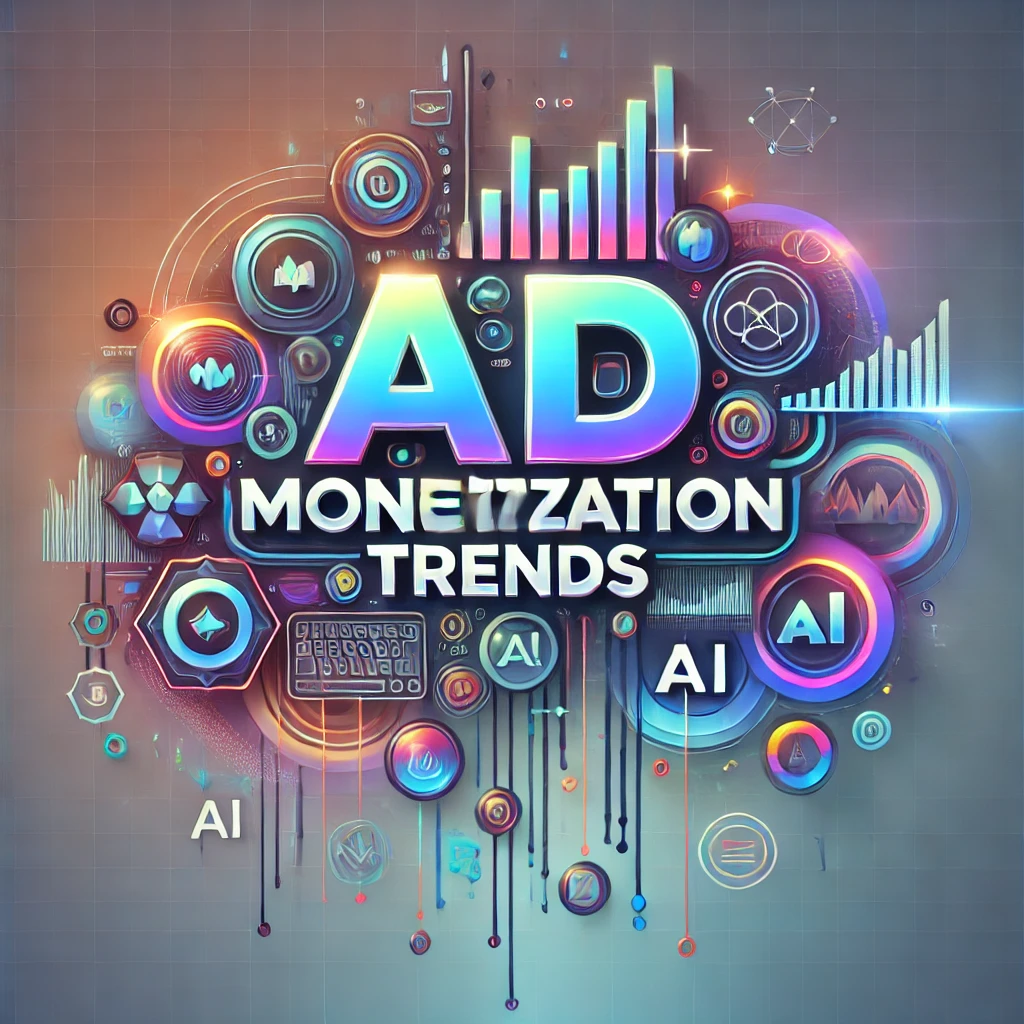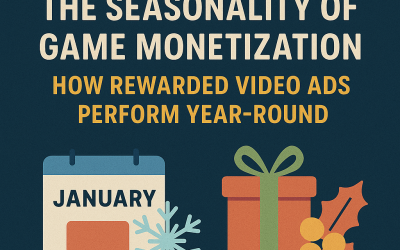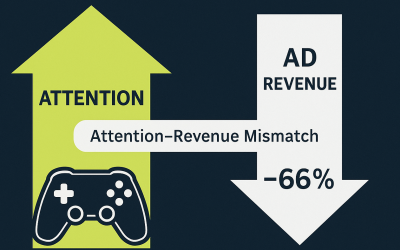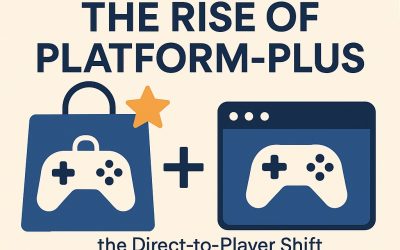Key Trends Shaping Web and Mobile Ad Monetization
Ad monetization strategies for web and mobile platforms are evolving rapidly, driven by shifting user expectations, privacy regulations, and technological advancements. To stay ahead, developers and advertisers must understand the latest trends reshaping the industry. Below, we explore the key developments in ad monetization for 2024 and beyond.
Contents
- 1 1. Privacy-First Approaches
- 2 2. AI-Driven Optimization
- 3 3. Innovative Ad Formats
- 4 4. Programmatic Advertising and Real-Time Bidding (RTB)
- 5 5. Hybrid Monetization Models
- 6 6. AI-Powered Apps and Spending
- 7 7. Blockchain Solutions for Transparency
- 8 8. User-Centric Monetization
- 9 9. Rising Importance of eCPM and ARPDAU
- 10 10. Demand for Flexible Ad Platforms
- 11 Final Thoughts
1. Privacy-First Approaches
User privacy remains a dominant factor influencing ad monetization. Regulations like GDPR and CCPA, combined with growing user awareness, are pushing advertisers and developers toward privacy-friendly solutions.
- Contextual Advertising: Unlike traditional ads that rely on user data, contextual advertising focuses on the content of a webpage or app. By analyzing keywords and themes, ads can be tailored without needing personal data. This approach respects privacy while maintaining relevance.
- First-Party Data Collection: Developers are shifting to first-party data strategies, relying on information collected directly from their platforms. This data, such as in-app behavior and preferences, allows for personalized ads while complying with privacy laws.
These trends demonstrate a growing emphasis on user trust, making privacy a central aspect of ad monetization strategies.
2. AI-Driven Optimization
Continuing on Key Trends Shaping Web and Mobile Ad Monetization post, Artificial Intelligence (AI) has become a cornerstone of modern ad monetization, enabling developers to improve efficiency, precision, and ROI.
- Predictive Analytics: AI algorithms analyze vast datasets to predict user behavior. These insights allow advertisers to create highly targeted campaigns, improving engagement and conversion rates.
- Dynamic Creative Optimization (DCO): AI customizes ad content in real-time, tailoring visuals, text, and calls-to-action to suit individual users. This level of personalization leads to higher click-through rates (CTR) and overall ad performance.
- Automated Campaign Management: With AI handling tasks like bid adjustments, budget allocation, and performance analysis, advertisers can focus on strategy. This automation boosts scalability while reducing the time spent on manual optimizations.
AI’s ability to streamline processes and enhance outcomes ensures its continued role in shaping the future of ad monetization.
3. Innovative Ad Formats
Creative ad formats are driving user engagement, with developers experimenting to find the most effective methods of monetization:
- Rewarded Ads: Rewarded video ads have become a favorite in the gaming industry. By offering users incentives, such as in-game credits or access to premium content, these ads enhance user satisfaction and retention.
- Native Ads: Native ads seamlessly blend into the content environment, appearing as natural extensions rather than disruptive promotions. This format works particularly well in apps and websites with high user engagement.
- AR and VR Ads: Augmented Reality (AR) and Virtual Reality (VR) ads offer immersive experiences that captivate users. From virtual product try-ons to interactive game environments, AR and VR ads show great potential for boosting engagement and conversions.
These formats cater to diverse user preferences, ensuring both effective monetization and a positive user experience.
4. Programmatic Advertising and Real-Time Bidding (RTB)
Continuing on Key Trends Shaping Web and Mobile Ad Monetization post, Programmatic advertising continues to grow due to its ability to automate and optimize ad buying in real time.
- AI-Enhanced RTB: Real-Time Bidding (RTB) involves auctioning ad space as users load a webpage or app. AI improves this process by analyzing factors like audience demographics, engagement potential, and bid pricing, ensuring maximum value for each impression.
- Header Bidding: Unlike traditional waterfall systems, header bidding enables multiple advertisers to bid simultaneously for ad space. This competition drives up ad inventory value and ensures developers achieve higher eCPMs.
The increasing adoption of programmatic advertising highlights the industry’s focus on efficiency, scalability, and transparency.
5. Hybrid Monetization Models
Monetization is no longer about choosing between ads and subscriptions—hybrid models are becoming the norm:
- Subscription + Advertising: Many platforms now offer a choice between free ad-supported experiences and ad-free subscriptions. This model appeals to a broader audience, maximizing revenue while catering to different user preferences.
- In-App Purchases (IAP) + Advertising: Combining in-app purchases with ads allows developers to diversify revenue streams. For example, users can watch rewarded ads for extra lives in games while having the option to purchase premium features directly.
Hybrid models create a balanced approach, ensuring sustainable monetization without alienating users.
6. AI-Powered Apps and Spending
Continuing on Key Trends Shaping Web and Mobile Ad Monetization post, AI-driven apps are not only shaping ad strategies but also fueling consumer spending trends:
- AI-Powered Features: AI applications such as virtual assistants, productivity tools, and personalized learning platforms are gaining traction. Many of these apps use subscription models to monetize, with additional features available through paid tiers.
- Ad Integrations: AI-powered apps can enhance ad experiences by tailoring content to users’ needs and preferences, resulting in more meaningful interactions and higher conversion rates.
As the role of AI in digital experiences grows, its influence on ad monetization strategies will deepen.
7. Blockchain Solutions for Transparency
Blockchain technology is making its way into ad monetization, offering innovative solutions for common challenges:
- Ad Fraud Prevention: Blockchain ensures that ad impressions are verified and accurately recorded, reducing fraudulent activities like fake clicks and impressions.
- Transparent Transactions: With blockchain, advertisers and developers can track every step of their transactions, ensuring fair revenue sharing and trust among stakeholders.
Although adoption is still in its early stages, blockchain’s potential to enhance transparency and security is undeniable.
8. User-Centric Monetization
Continuing on Key Trends Shaping Web and Mobile Ad Monetization post, Prioritizing the user experience is critical for long-term success in ad monetization:
- Non-Intrusive Ads: Formats like native and rewarded ads are designed to complement the user journey rather than interrupt it, maintaining engagement and satisfaction.
- Personalized Content: Leveraging first-party data and AI, developers can deliver ads that feel relevant and valuable to users, fostering a positive relationship with their audience.
Focusing on user-centric strategies ensures higher retention rates and sustainable revenue growth.
9. Rising Importance of eCPM and ARPDAU
Metrics like effective cost per mille (eCPM) and average revenue per daily active user (ARPDAU) are becoming essential in evaluating ad performance:
- eCPM Optimization: Developers and advertisers are using advanced analytics to identify the highest-performing ad placements and formats, maximizing revenue per impression.
- ARPDAU Insights: Tracking ARPDAU helps developers measure the effectiveness of their monetization strategies relative to active user engagement.
Understanding and optimizing these metrics enables data-driven decision-making and improves overall profitability.
10. Demand for Flexible Ad Platforms
Developers are increasingly looking for versatile ad platforms that offer seamless integrations and robust analytics:
- Multi-Channel Support: Ad platforms must cater to various formats, including rewarded video ads, native ads, and banner ads, to meet developers’ diverse needs.
- Comprehensive Dashboards: Analytics tools that track key performance indicators (KPIs) like CTR, eCPM, and user retention are essential for optimizing strategies.
The demand for flexible platforms reflects the complexity and diversity of modern ad monetization strategies.
Final Thoughts
Last but not least on my Key Trends Shaping Web and Mobile Ad Monetization post, the ad monetization landscape for web and mobile platforms is rapidly evolving, shaped by trends like privacy-first strategies, AI optimization, innovative ad formats, and hybrid monetization models. Developers who stay informed and adapt to these shifts will position themselves for sustainable growth and success.
As 2024 unfolds, these trends will continue to redefine how ads engage users and generate revenue. Embracing these advancements ensures developers remain competitive in an ever-changing digital environment.


